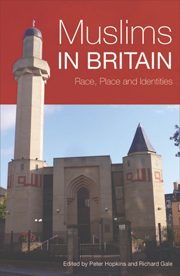Book contents
- Frontmatter
- Contents
- Acknowledgements
- List of contributors
- List of tables
- List of figures
- 1 Introduction: Muslims in Britain – race, place and the spatiality of identities
- Section 1 Gender, place and culture
- Section 2 Landscapes, communities and networks
- Section 3 Religion, race and difference
- 10 Situating Muslim geographies
- 11 Muslims and the politics of difference
- 12 Islamophobia in the construction of British Muslim identity politics
- Afterword
- Index
10 - Situating Muslim geographies
from Section 3 - Religion, race and difference
Published online by Cambridge University Press: 05 August 2013
- Frontmatter
- Contents
- Acknowledgements
- List of contributors
- List of tables
- List of figures
- 1 Introduction: Muslims in Britain – race, place and the spatiality of identities
- Section 1 Gender, place and culture
- Section 2 Landscapes, communities and networks
- Section 3 Religion, race and difference
- 10 Situating Muslim geographies
- 11 Muslims and the politics of difference
- 12 Islamophobia in the construction of British Muslim identity politics
- Afterword
- Index
Summary
Introduction: (re-)emergent geographies of religion
Since the beginning of this century, two collections of essays in important and well-regarded journals of geography gave dedicated attention to the phenomenon of religion. In 2002, Julian Holloway and Oliver Valins led a themed section in Social and Cultural Geography on ‘placing religion and spirituality in geography’, while in 2006, James Proctor (2006) organised a forum in the Annals of the Association of American Geographers on ‘theorizing and studying religion’. The AAG's study group on Geographies of Religion and Belief Systems has started a new online journal of the same name. A new book on the Geographies of Muslim Women (Falah and Nagel 2005) brings together a range of essays focusing on different parts of the globe, while a new edited collection on Geographies of Muslim Identities has just hit the bookstands (Aitchison et al. 2007). In the mean time, a host of papers examining various aspects of religion and geography has been produced in the last decade, more so than in the preceding 20 to 30 years (just some examples are: Chivallon 2001; Dunn 2001; Dwyer 1999a, 1999b; Graham 1998; Graham and Murray 1997; Henkel 2005; Hervieu-Leger 2002; Knippenberg 1998; Kong 2002, 2005a and b, 2006; Tong and Kong 2000; Livingstone et al. 1998; Nagar 1997; Numrich 1997; Pacione 2005; Prorok 2003; Raivo 1997, 2002; Sidorov 2000a, 2000b; Slater 2004; Valins 2003; Vincent and Warf 2002; Zelinsky 2001).
- Type
- Chapter
- Information
- Muslims in BritainRace, Place and Identities, pp. 171 - 192Publisher: Edinburgh University PressPrint publication year: 2009



